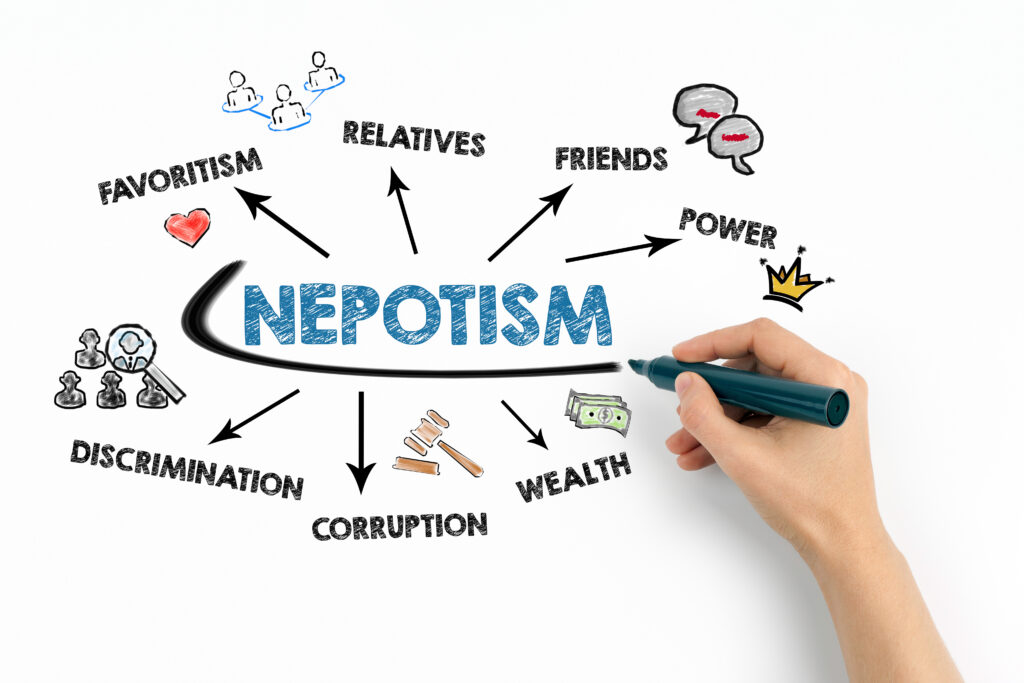
NEPOTISM: Buzzword or Buzzkill?
Nepotism. You may have felt your emotions stir as you read that word. It’s one of those terms that tends to come with baggage. For many, it immediately evokes feelings of an “unfair” advantage, whispered office gossip, and a clear sense of injustice that seems black and white. However, a closer look reveals something more complex, with shades of gray where family or close relationships can open doors and don’t always exclude fairness or competence.
It’s a word that can spark debate at dinner tables, board meetings, or even in casual conversations among colleagues. And yet, while it does carry undeniable risks, nepotism also has potential advantages when managed thoughtfully. Understanding its nuances is critical to having constructive conversations in both business and society.
What Nepotism Is – and Is Not
At its simplest, nepotism refers to favoring relatives or close friends in professional advancement, hiring, or access to resources because of the relationship rather than merit alone.
But here’s the tension: not every instance of a child working in the family business, or friends becoming business partners, counts as negative nepotism. Family-owned restaurants, for example, often rely on multiple generations pitching in – not just because of the bloodline but because those individuals have grown up steeped in the values, skills, and rhythms of the business. In that case, the “hire” isn’t simply about family ties – it’s about continuity and culture.
It’s important to differentiate between:
- Skill-based hires identified through relationships: When a person’s connection brings them to an opportunity, but their skills and work ethic keep them there, the hire is less about nepotism in its harmful sense and more about leveraging networks and insight to match roles and talent.
- Unfair advantage: Nepotism crosses the line when unearned privilege trumps merit, stifling others’ opportunities and harming morale. That’s when the word takes on its sting.
Common Misconceptions
One of the biggest misconceptions is that any family or friend involvement automatically undermines fairness. Let’s face it, the term “Nepo-baby” is rarely meant to be flattering – it’s shorthand for privilege without proof.
In reality, though:
- Many renowned family businesses have succeeded by passing down values and expertise, not just family names.
- Close professional ties aren’t unique to families; school ties, fraternity networks, or long-term friendships can play just as big a role in who gets opportunities. That’s often called cronyism – a cousin of nepotism.
- Until relatively recently, most professional paths around the world were shaped by family tradition – being apprenticed to your father, mother, or uncle wasn’t seen as suspect. It was the norm.
In other words, today’s heated debates about nepotism are as much about changing cultural values as they are about fairness.
The Numbers: Family Businesses Across the Globe
Consider this: the 500 largest family businesses generate about $8.8 trillion in annual revenue and employ over 25 million people. If those businesses were a single country, they’d have the world’s third-largest economy.
Walmart, Ford, BMW – these names aren’t just brands, they’re legacies. They remind us that family involvement can create continuity, resilience, and long-term thinking. At the same time, they remind us that survival across generations isn’t automatic. Studies show only about 30% of family businesses make it to the second generation, and just 12% survive into the third. Legacy, without adaptability, is fragile.
Success Stories – and Failures
Noteworthy Successes
- House of Morgan: The Morgan family legacy, chronicled in history and documentaries, is a prime example. Despite being overshadowed by the legendary J.P. Morgan, later generations built, managed, and sometimes struggled with the firm’s prominence on Wall Street, navigating skepticism to lead with competence.
- Walton family (Walmart): From Sam Walton to the next generation, this family leaned on strong values, strategic reinvention, and governance reforms to help maintain growth and performance – proving that succession doesn’t have to mean stagnation.
- Ford family (Ford Motor Company): Henry’s creativity spawned numerous industries and changed the world immeasurably. Continued family involvement, paired with external business leadership, has sustained innovation and resilience over a century.
Well-known Failures
- Sears, Roebuck and Co.: The founding Sears family lost touch with evolving trends and ignored e-commerce, leading to bankruptcy – a warning that even successful legacies can falter without adaptation.
- Anheuser-Busch: Five generations of family control ended when unresolved internal disputes and a lack of clear succession planning allowed for a takeover, illustrating the dangers of internal conflict and complacency.
These stories highlight the razor’s edge family businesses walk: legacy can either be a stabilizer or a stumbling block.
Friends, Cronyism, and Business
Of course, nepotism’s close relative – cronyism – plays its part. Partnerships among friends can be powerful. Shared trust, complementary skills, and deep loyalty can accelerate innovation. Think of the garage startups that became Silicon Valley titans.
But there’s risk too. Overly casual boundaries, reluctance to confront poor performance, or insulating the business within a limited social circle can breed complacency. When accountability is sacrificed for comfort, businesses suffer.
The key difference between nepotism and cronyism may be the family tie, but the effect can be strikingly similar: both can either fuel loyalty and growth or undermine fairness and opportunity.
Advantages and Pitfalls
Advantages
- Deep understanding, shared values, and long-term commitment often boost organizational stability and culture in family businesses.
- Legacy enterprises contribute massively to local and global economies, creating jobs and community resilience.
Pitfalls
- When favoritism replaces merit, resentment, disengagement, and stagnation may follow – potentially crippling innovation and morale.
- Overlooked succession planning, resistance to change, and internal family or friend disputes are leading causes of failure for even the most successful enterprises.
Conclusion
Nepotism, at its best, is about legacy, mentorship, and continuity. It can be the glue that binds generations and preserves values. But unchecked, it risks eroding fairness, undermining organizations, and blocking new talent from rising.
The challenge, then, isn’t to eliminate nepotism – it’s to manage it transparently, balance it with merit, and keep adaptability front and center. In that balance lies the difference between nepotism as a buzzword that sparks criticism and nepotism as a foundation for sustainable growth.














0 Comments